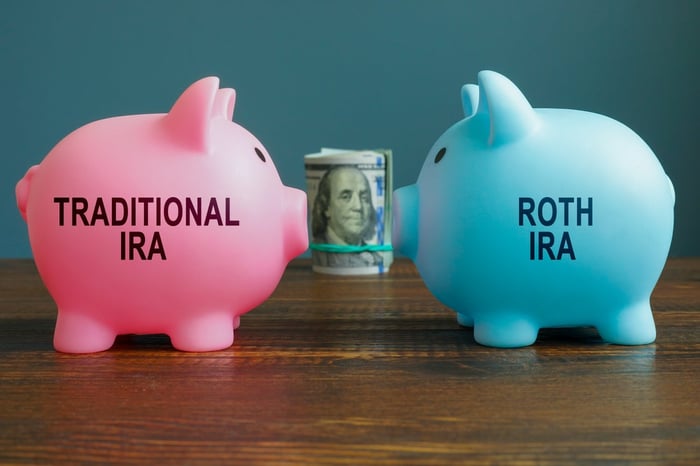Key Points
-
IRA income limitations make it difficult to save as much as you might like for retirement.
-
It’s the other benefits associated with IRAs that keep investors coming back for more.
-
IRAs allow investors to call the shots more than in employer-sponsored plans.
According to Gallup, approximately 6 in 10 Americans have money invested in a retirement savings plan, including 401(k)s, 403(b)s, and the ever-popular individual retirement account (IRA). While IRAs are terrific retirement plans, they’re not perfect. Specifically, low contribution limits can make it tough to sock away as much as you need to each year.

Image source: Getty Images.
Where to invest $1,000 right now? Our analyst team just revealed what they believe are the 10 best stocks to buy right now. Continue »
Contribution limits
The annual contribution limit for an IRA in 2025 is $7,000, with a catch-up contribution for individuals 50 and over of $1,000. That means the most you can contribute to an IRA is $8,000. While that’s nothing to sneeze at, it doesn’t come close to the amount you can put into a retirement plan like a 401(k). With an employer-sponsored 401(k), you can invest as much as $23,500 into your plan, not counting any funds your employer contributes.
If you’re self-employed and open a Solo 401(k) plan, you contribute in two ways: As the employee and the employer. Each portion has different contribution limits, but depending on how much money your business brings in, you may be able to contribute as much as $70,000 if you’re under 50. If you’re either 50 to 59 or age 64 or older, you can add another $7,500 in catch-up contributions.
Sweet benefits
As someone infatuated with my Solo 401(k) plan, I find its big selling point is the amount I can contribute annually. However, claiming that a 401(k) — or any other retirement plan — is better than an IRA due to its contribution limits would be unfair. The benefits offered by IRAs are too attractive to be overlooked.
Broader range of investment options
When you contribute to a 401(k), it’s your employer that decides which investment options are available. For example, more than 8,100 mutual funds are currently available on the market. Of those 8,100 funds, your employer must narrow the selection down to what 401khelpcenter.com calls “a handful or two.” Granted, the law requires employers to vet the funds they allow into their plans, but still, it’s their decision.
One thing that makes IRAs so popular is the sheer number of investment options available. If you’re particular about your investments, you’ll appreciate the opportunity to pick and choose what’s right for you.
Opportunity to pay less and control more
Let’s say you want to open an IRA. While an employer-sponsored plan sets its fees in stone, you can shop around for an IRA with low management fees. Once you’ve decided on an account through your bank, credit union, or brokerage, you’ll sort through the vast array of investments to determine which best fit your goals and risk tolerance. If something isn’t working out for you down the road, it’s you who makes the call to switch things up.
If you crave financial control, an IRA might be irresistible.
Tax strategy
With an IRA, you also have greater control over how and when you pay taxes on your investments. For example, a traditional IRA often allows you to contribute pretax income. This move lowers your taxable income for the year and enables you to pay taxes only when withdrawals are made in retirement.
On the other hand, contributions to a Roth IRA are made with after-tax dollars, meaning you won’t get a tax break now, but you also won’t have to pay taxes on those funds when you retire. You can decide on the best time for you to pay taxes on contributions and earnings. Note: There are income limits associated with Roth IRAs, so be sure to check those out if a Roth plan is an investment you’re interested in taking advantage of now.
Despite the fact they’re not perfect, it’s no surprise IRAs are so popular. Now, if they’d only raise the contribution limit.
The $23,760 Social Security bonus most retirees completely overlook
If you’re like most Americans, you’re a few years (or more) behind on your retirement savings. But a handful of little-known “Social Security secrets” could help ensure a boost in your retirement income.
One easy trick could pay you as much as $23,760 more… each year! Once you learn how to maximize your Social Security benefits, we think you could retire confidently with the peace of mind we’re all after. Join Stock Advisor to learn more about these strategies.
View the “Social Security secrets” »
The Motley Fool has a disclosure policy.






